Dinger's Aviation Pages
JOHN DELL AVIATION ILLUSTRATION
ALL IMAGES COPYRIGHT JOHN DELL. ASK FOR PERMISSION BEFORE USING ANY IMAGE OR POSTING ON ANY OTHER SITE.
I love painting aircraft, and I have always had a great interest in British aviation between the wars. Here are just a few for you to look at...
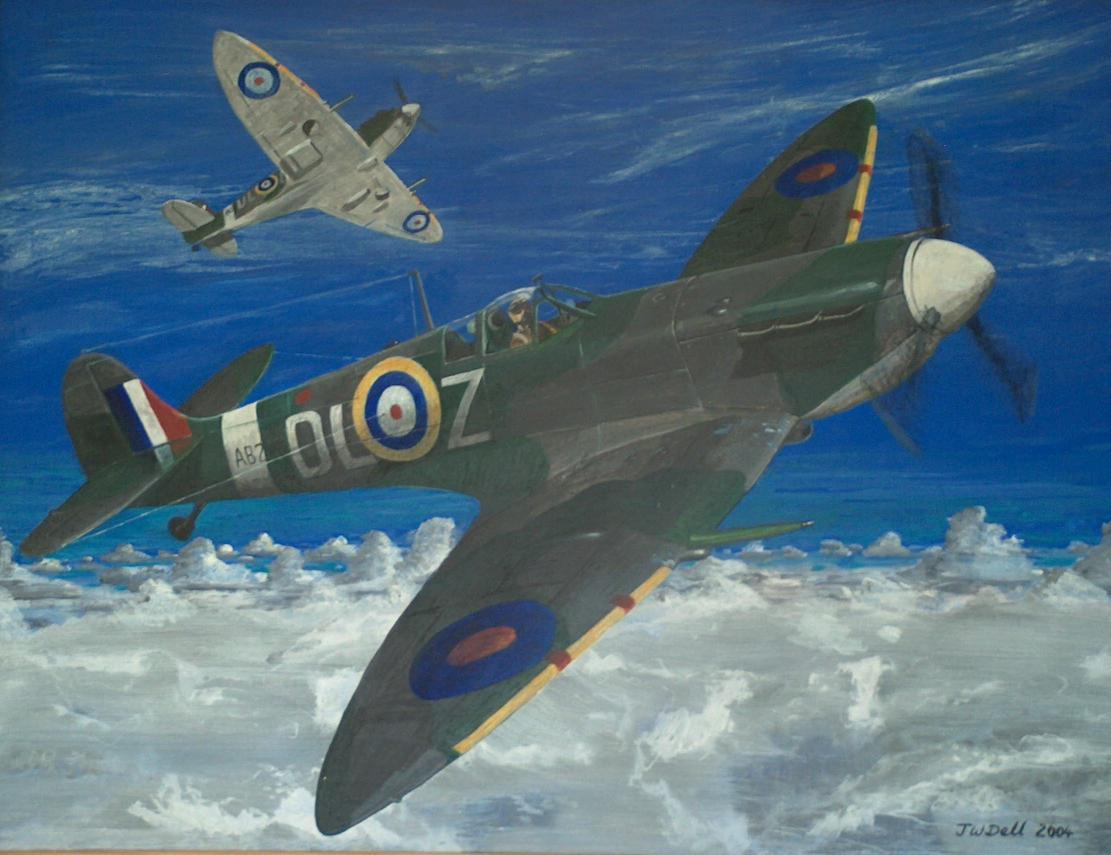
Two Supermarine Spitfire Mk Vs of 91 Squadron in the colours worn in early 1942. Image © John Dell

The Canadian Gregor FDB-1 painted as if it had made it into production and service. Image © John Dell

Winston Churchill, then First Lord of the Admiralty, spent part of Christmas Day 1939 watching an anti-aircraft gunnery demonstration at Eastney, near Portsmouth. One of the Blackburn Shark biplanes involved towed a target with "Merry Christmas" written on it. While the demonstration was going on it started to snow heavily. I've tried to capture the scene to illustrate the book "So Be It! by Don Sutherland. Image © John Dell

The amazing DH Hornet was just too late to see service in World War II - Here I've painted it as if it had got into a service a year earlier. in action with Me 163 Komet rocket fighters. Image © John Dell
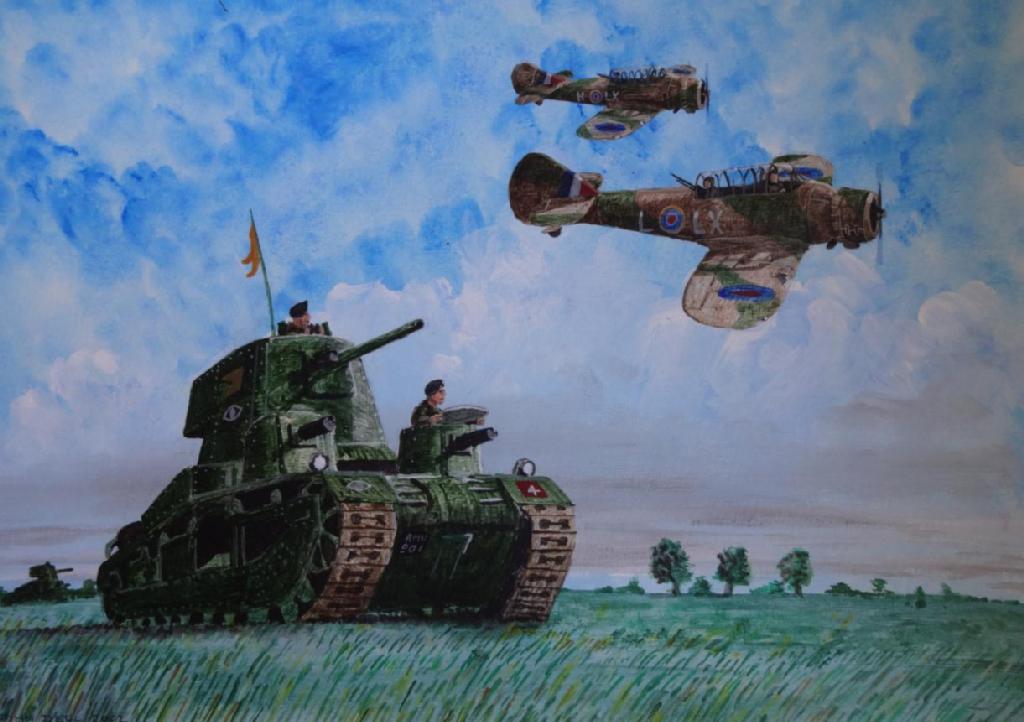
Two intriguing "might-have beens". The Bristol 148 was an army co-operation aircraft designed by Bristol that lost out to the Westland Lysander. The 148 might have faired a lot better in France in 1940 than the Lysander, especially if fitted with the Bristol Taurus engine. The A6 Medium III "16 tonner" tank was designed to replace the Vickers medium II tanks that soldiered on from the 1920s until the eve of World War II. Only a handfull of prototypes "16 tonners" were built. Image © John Dell
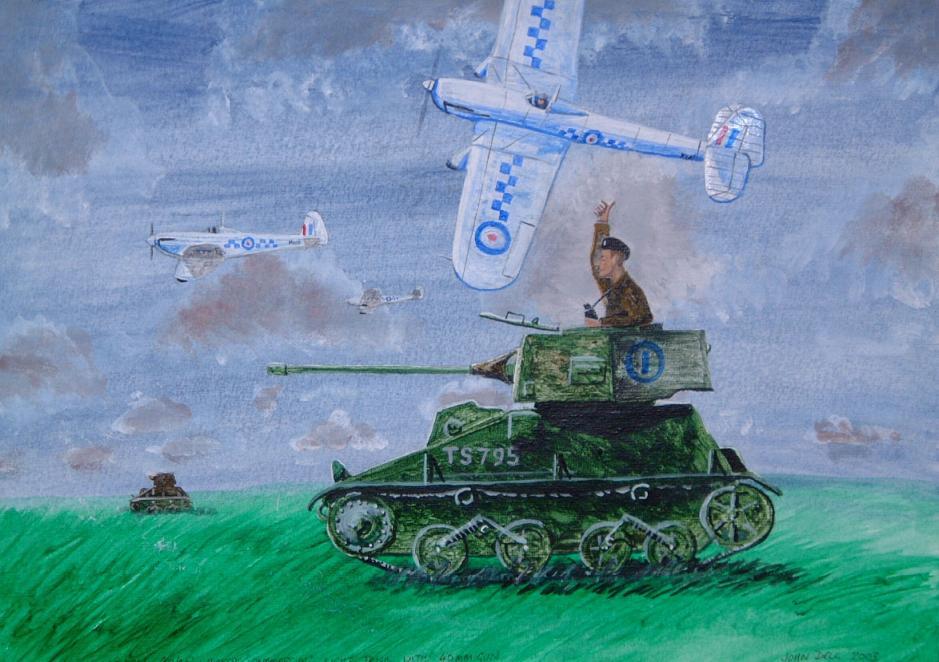
Another juxtaposition of two "might-have-beens". The Supermarine Type 224, the underperforming predecessor to the Spitfire, and the Vickers Commercial Tank, "model 1937" with Vickers semi-automatic 40 mm gun. The type 224 would undoubtedly have been a disaster if it had entered large scale service being slow and with an evaporative cooling system that would have been vulnerable to damage from even the smallest calibre weapon. The Vickers tank, or rather its 40 mm gun, is another matter. A magazine-fed, semi-automatic gun of this calibre would have been the ideal weapon for light tanks and armoured cars, able to fire 5 or 6 rounds in quick succession before reloading. Image © John Dell

Flying boats had to have a deep hull to keep the airscrews clear of the water. The Blackburn B20 was designed so that the whole bottom of the fuselage could be extended to form a central float and wingtip floats folded down to provide support. Once retracted these gave the B20 a streamlined profile and the single prototype built had a sparkling performance, being as fast as a Beaufighter. The prototype crashed during the test program and the Catalina flying boat was purchased from America instead. As originally designed the B20 was to be powered by 24 cylinder Vulture in-line engines. In the picture above I have painted the B20 as it may have looked with the more reliable Hercules radial engine. Image © John Dell
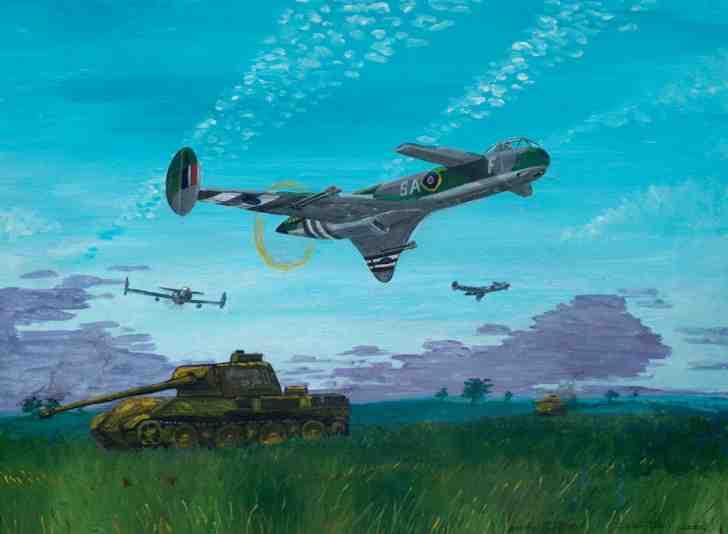
The Boulton Paul P100 was an unbuilt project for a canard pusher-engined specialised ground attack aircraft - read about it here. Image © John Dell
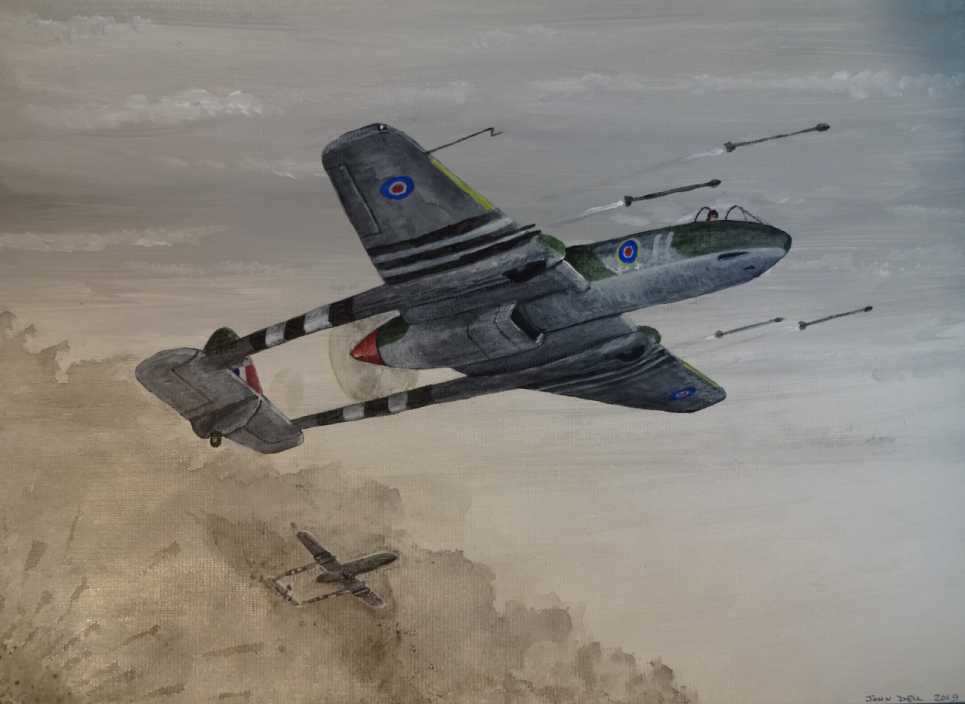
The Boulton Paul P99 was another unbuilt project for a specialised ground attack aircraft - read about it here. Image © John Dell

Designed to be mass produced the Martin-Baker MB2 used the Napier Dagger in-line air cooled engine. I've painted it as if it had gone into production, attacking a He 111 bomber. The MB2 featured a fixed, "trousered" undercarriage to simplify production. It used Martin-Baker's unique design feature of a tubular metalwork lattice covered by easily-detachable metal skinning which greatly simplified maintenance. The Napier Dagger engine had a sorry history when used in the HP Hereford bomber; it's high speed whine was unpleasant for crews on long missions and the difference in temperature between taxing and flying caused the engine to seize up. It might have performed better as a fighter engine, with shorter mission times and shorter taxiing runs. Image © John Dell
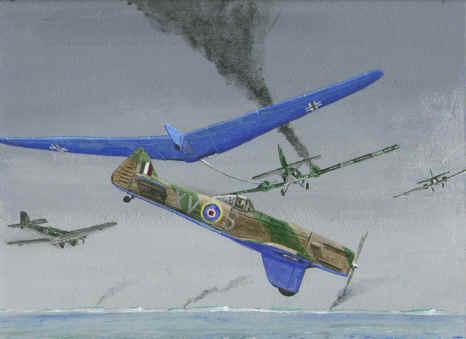
Another painting of the Martin-Baker MB2. This one shows how it might have appeared shooting down a Ju52 towing a Horten ammunition carrier glider (as planned to be used during the Invasion of Britain). Image © John Dell
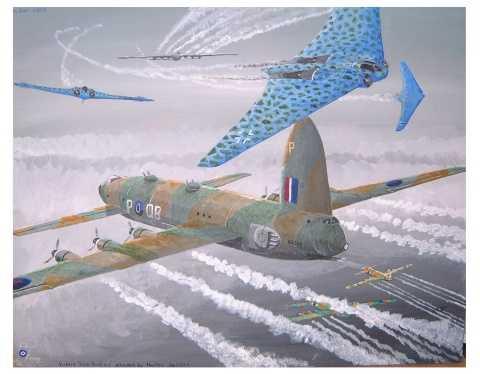
In 1942 Vickers did a design study on a "next generation" bomber, it had an unusual canard layout and was to be powered by six massive Centaurus engines and have a heavy cannon armament mounted in turrets. If the war had dragged on into the late 40's it could have joined the B-29s and B-36's (and perhaps B-35s) of the USA in attacking Germany and Japan. In this scenario a likely opponent would have been the Horten Ho 229 (often refered to as the Gotha Go 229, a designation it would not have taken into service) an advanced flying wing design. Image © John Dell
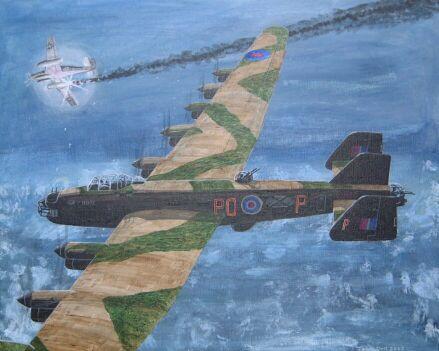
Avro did design studies for the same requirement. One of the projects was for a super-stretched Lancaster with 10 Giffon engines with contra-props. Shown here at night after a brush with an Me262B-2a night fighter. Thanks to Dave Dixon who worked at Avro and supplied me with the information to do this painting. Image © John Dell
ALL IMAGES COPYRIGHT JOHN DELL. ASK FOR PERMISSION BEFORE USING ANY IMAGE OR POSTING ON ANY OTHER SITE.
I love painting aircraft, and I have always had a great interest in British aviation between the wars. Here are just a few for you to look at...

Two Supermarine Spitfire Mk Vs of 91 Squadron in the colours worn in early 1942. Image © John Dell

The Canadian Gregor FDB-1 painted as if it had made it into production and service. Image © John Dell

Winston Churchill, then First Lord of the Admiralty, spent part of Christmas Day 1939 watching an anti-aircraft gunnery demonstration at Eastney, near Portsmouth. One of the Blackburn Shark biplanes involved towed a target with "Merry Christmas" written on it. While the demonstration was going on it started to snow heavily. I've tried to capture the scene to illustrate the book "So Be It! by Don Sutherland. Image © John Dell

The amazing DH Hornet was just too late to see service in World War II - Here I've painted it as if it had got into a service a year earlier. in action with Me 163 Komet rocket fighters. Image © John Dell

Two intriguing "might-have beens". The Bristol 148 was an army co-operation aircraft designed by Bristol that lost out to the Westland Lysander. The 148 might have faired a lot better in France in 1940 than the Lysander, especially if fitted with the Bristol Taurus engine. The A6 Medium III "16 tonner" tank was designed to replace the Vickers medium II tanks that soldiered on from the 1920s until the eve of World War II. Only a handfull of prototypes "16 tonners" were built. Image © John Dell

Another juxtaposition of two "might-have-beens". The Supermarine Type 224, the underperforming predecessor to the Spitfire, and the Vickers Commercial Tank, "model 1937" with Vickers semi-automatic 40 mm gun. The type 224 would undoubtedly have been a disaster if it had entered large scale service being slow and with an evaporative cooling system that would have been vulnerable to damage from even the smallest calibre weapon. The Vickers tank, or rather its 40 mm gun, is another matter. A magazine-fed, semi-automatic gun of this calibre would have been the ideal weapon for light tanks and armoured cars, able to fire 5 or 6 rounds in quick succession before reloading. Image © John Dell

Flying boats had to have a deep hull to keep the airscrews clear of the water. The Blackburn B20 was designed so that the whole bottom of the fuselage could be extended to form a central float and wingtip floats folded down to provide support. Once retracted these gave the B20 a streamlined profile and the single prototype built had a sparkling performance, being as fast as a Beaufighter. The prototype crashed during the test program and the Catalina flying boat was purchased from America instead. As originally designed the B20 was to be powered by 24 cylinder Vulture in-line engines. In the picture above I have painted the B20 as it may have looked with the more reliable Hercules radial engine. Image © John Dell

The Boulton Paul P100 was an unbuilt project for a canard pusher-engined specialised ground attack aircraft - read about it here. Image © John Dell

The Boulton Paul P99 was another unbuilt project for a specialised ground attack aircraft - read about it here. Image © John Dell

Designed to be mass produced the Martin-Baker MB2 used the Napier Dagger in-line air cooled engine. I've painted it as if it had gone into production, attacking a He 111 bomber. The MB2 featured a fixed, "trousered" undercarriage to simplify production. It used Martin-Baker's unique design feature of a tubular metalwork lattice covered by easily-detachable metal skinning which greatly simplified maintenance. The Napier Dagger engine had a sorry history when used in the HP Hereford bomber; it's high speed whine was unpleasant for crews on long missions and the difference in temperature between taxing and flying caused the engine to seize up. It might have performed better as a fighter engine, with shorter mission times and shorter taxiing runs. Image © John Dell

Another painting of the Martin-Baker MB2. This one shows how it might have appeared shooting down a Ju52 towing a Horten ammunition carrier glider (as planned to be used during the Invasion of Britain). Image © John Dell

In 1942 Vickers did a design study on a "next generation" bomber, it had an unusual canard layout and was to be powered by six massive Centaurus engines and have a heavy cannon armament mounted in turrets. If the war had dragged on into the late 40's it could have joined the B-29s and B-36's (and perhaps B-35s) of the USA in attacking Germany and Japan. In this scenario a likely opponent would have been the Horten Ho 229 (often refered to as the Gotha Go 229, a designation it would not have taken into service) an advanced flying wing design. Image © John Dell

Avro did design studies for the same requirement. One of the projects was for a super-stretched Lancaster with 10 Giffon engines with contra-props. Shown here at night after a brush with an Me262B-2a night fighter. Thanks to Dave Dixon who worked at Avro and supplied me with the information to do this painting. Image © John Dell
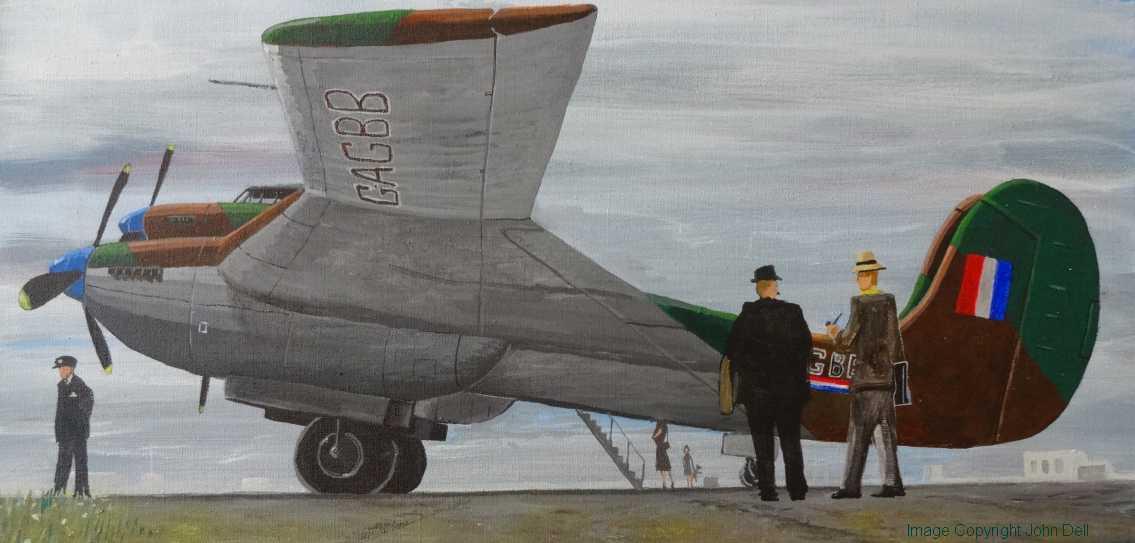
The Willoughby Delta 9 was a project for a twin-boom pressurised airliner. I've painted it in a "might-have-been" scenario where it replaces the DC-3 on the infamous "Flight 777" from Lisbon. You can read about the alternative Flight 777 scenario by <clicking here>. Image © John Dell
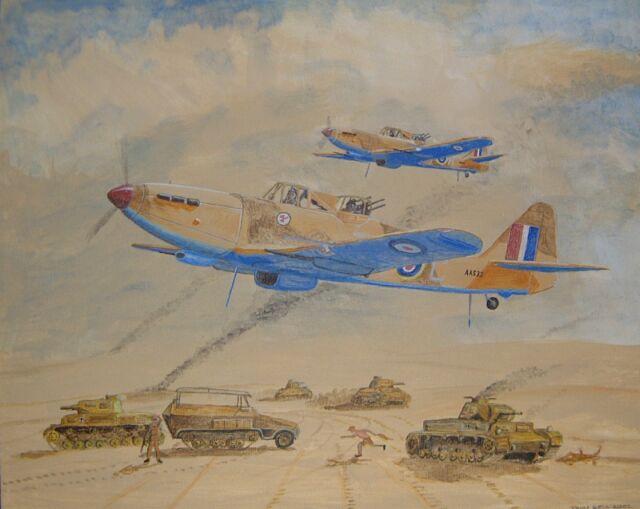
Boulton Paul Defiants painted as if they had been fitted with 40 mm anti-tank guns (one under each wing) and used in the Western Desert in place of the "can-opener" Hurricanes that actually operated there. Image © John Dell
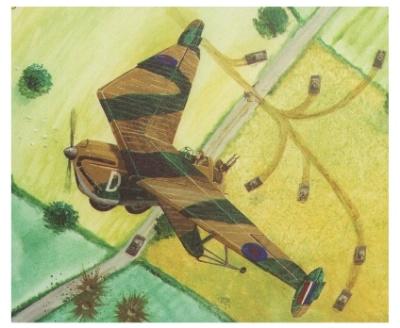
The Westland Pterodactyl Mk V. Designed as a two seat fighter. the radical tailess layout gave the gunner a superb field of fire. The design lost out to the Hawker Demon. I have painted the Pterodactyl Mk V as if it had been used for Army co-operation duties during the Battle of France. Image © John Dell
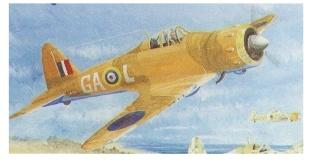
Detail from a larger painting with the Gloster F5/34 painted as if it had seen combat in the western desert. In this case the codes are those of a Kittyhawk squadron. Just two prototype F5/34 s were produced. The design is often compared with the Mitsubishi Zero, but in fact its heavier structure and crude backward retracting undercarriage have more in common with the Seversky P-35. Image © John Dell

RJ Mitchell's design for a bomber would have been an outstanding aircraft if it had gone into production. I have painted it as originally designed with a single large fin. The aircraft attacking it are Heinkel 100 fighters, a design of great promise which lost out to the Focke Wulf 190. The small production run was widely featured in the German press of the time as the "Heinkel 113". Image © John Dell

The Cunliffe Owen OA-1 "Flying Wing". Designed to compete against the Douglas DC3, only a single prototype was produced. I have painted it as if it had gone into production and been pressed into service by Coastal Command. Read more about it by clicking <here>. Image © John Dell
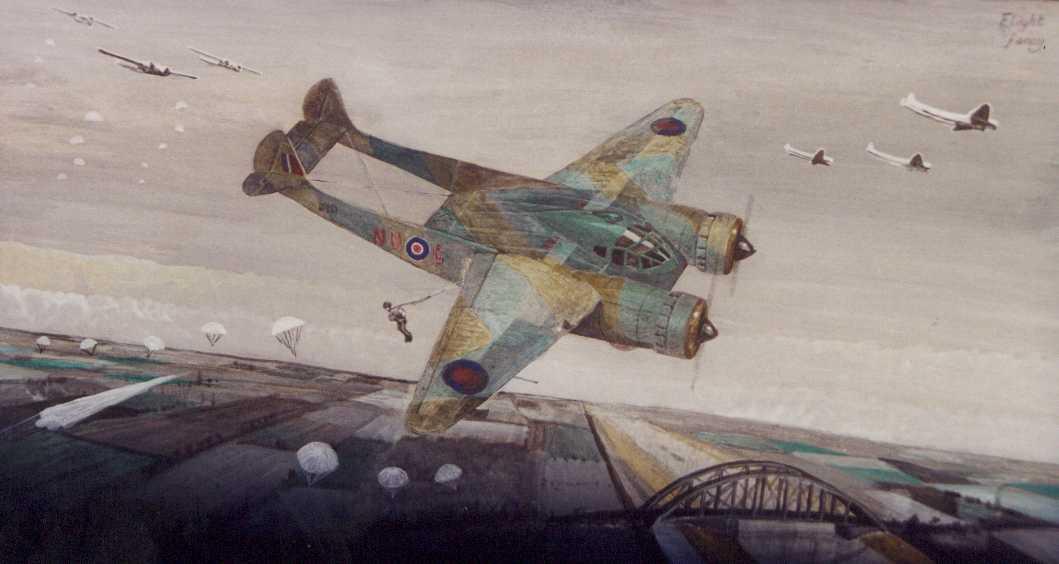
The Cunliffe Owen OA-1 as it might have looked if used as a transport aircraft by the RAF in WW2. In this case dropping paratroops over the low countries. Image © John Dell
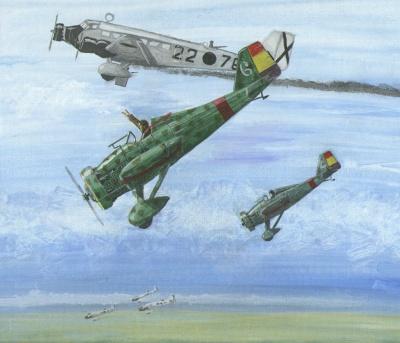
Above is my painting of the Vickers type 151 "Jockey". This advanced design first flew as early as 1930. It predates the famous Boeing P-26 which did not fly until 1932 and which was less advanced than the Type 151, (needing bracing wires to support the wing). I have painted the Type 151 as if it had gone into production and some examples had found their way to Spain to take part in the Civil War. The volunteer pilot is giving the Ju 52 he has just attacked a typically British "bowman's salute". I have based the painting on the late layout of the prototype. It is likely that if the 151 had gone into production it would have had a larger fin or increased fuselage side area to improve spin recovery. Image © John Dell
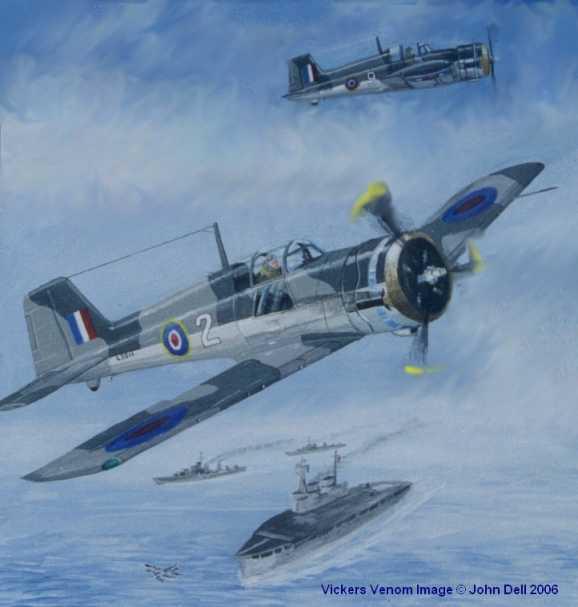
The Jockey was develped into the "Venom", a monoplane fighter with retracting main undercarriage, cockpit canopy and split flaps. I have painted it is if it had been adopted as a fighter for the Royal Navy in place of the Sea Gladiator. The colour scheme is appropriate to the Mediterranian in 1941. The aircraft carrier HMS Eagle is in the background. You can read more about the Venom on my webpage devoted to it CLICK HERE. Image © John Dell
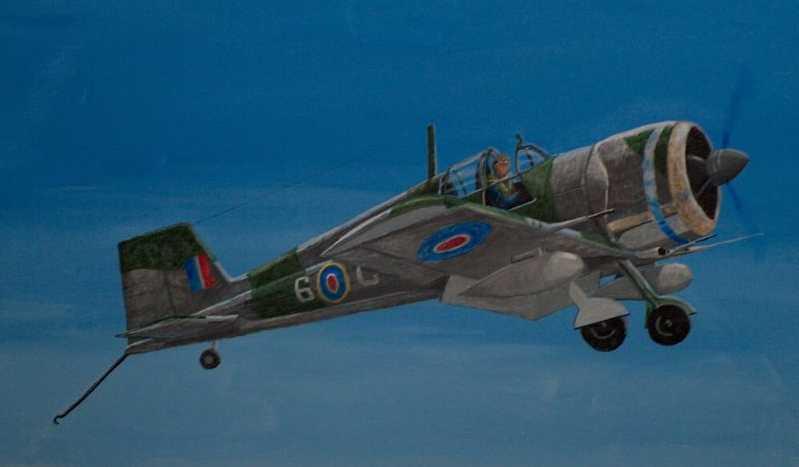
Here is a second painting of the Venom as a carrier fighter - this time a "Mk II" version with cannon, drop-tanks and a "stinger" arrestor hook. Image © John Dell

The General Aircraft Type 35 was tendered as a replacement for the DH "Queen Bee" and Airspeed "Queen Wasp" radio controlled drones (although it had provision for being piloted manually). An intriguing layout that might have lent itself to other uses. Image © John Dell
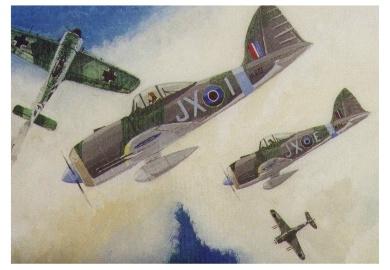
A Bristol study around the Hercules engine, the Type 153 was designed to meet spec F37/35 for a four cannon fighter. The specification was eventually met by the Westland Whirlwind. Image © John Dell
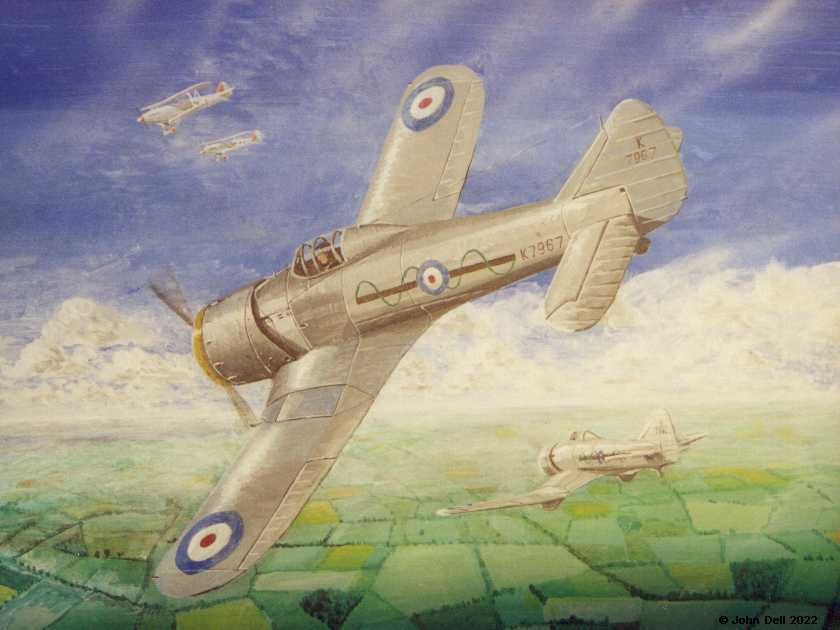
A painting of the Bristol Type 133, a very advanced design when it first flew in 1934, the Type 133 was designed to the specification which led to the Gloster Gladiator, the RAF's last biplane fighter. If the Prototype had not been lost in an avoidable accident the Type 133 might well have been selected instead of the Gladiator. The picture has a Type133 in the silver colours used by a Gladiator squadron in the inter-war period. Image © John Dell
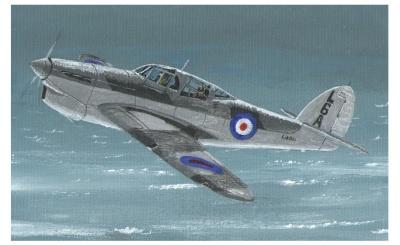
The Hawker Henley was a very advanced design. Two hundred were actually produced but they were only used as target tugs, a job they were ill suited for. The painting shows the Henley as it might have appeared if it had been used by the Royal Navy in an operational role (they did operate a handfull as target tugs). To read more about the the Hawker Henley <click here>. Image © John Dell

Here is another picture of a Hawker Henley, in this case attacking a German tank column in France in 1940, a task actually carried out with disastrous consequences by Fairey Battles. Image © John Dell
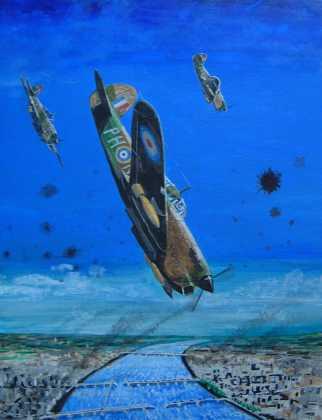
Yet more Henleys, this time dive-bombing bridges at Maastricht. A black and white version of this image featured in Peter C. Smiths book "The History of Dive Bombing" (Pen and Sword Edition ISBM 978-1-84415-592-7 ). Image © John Dell
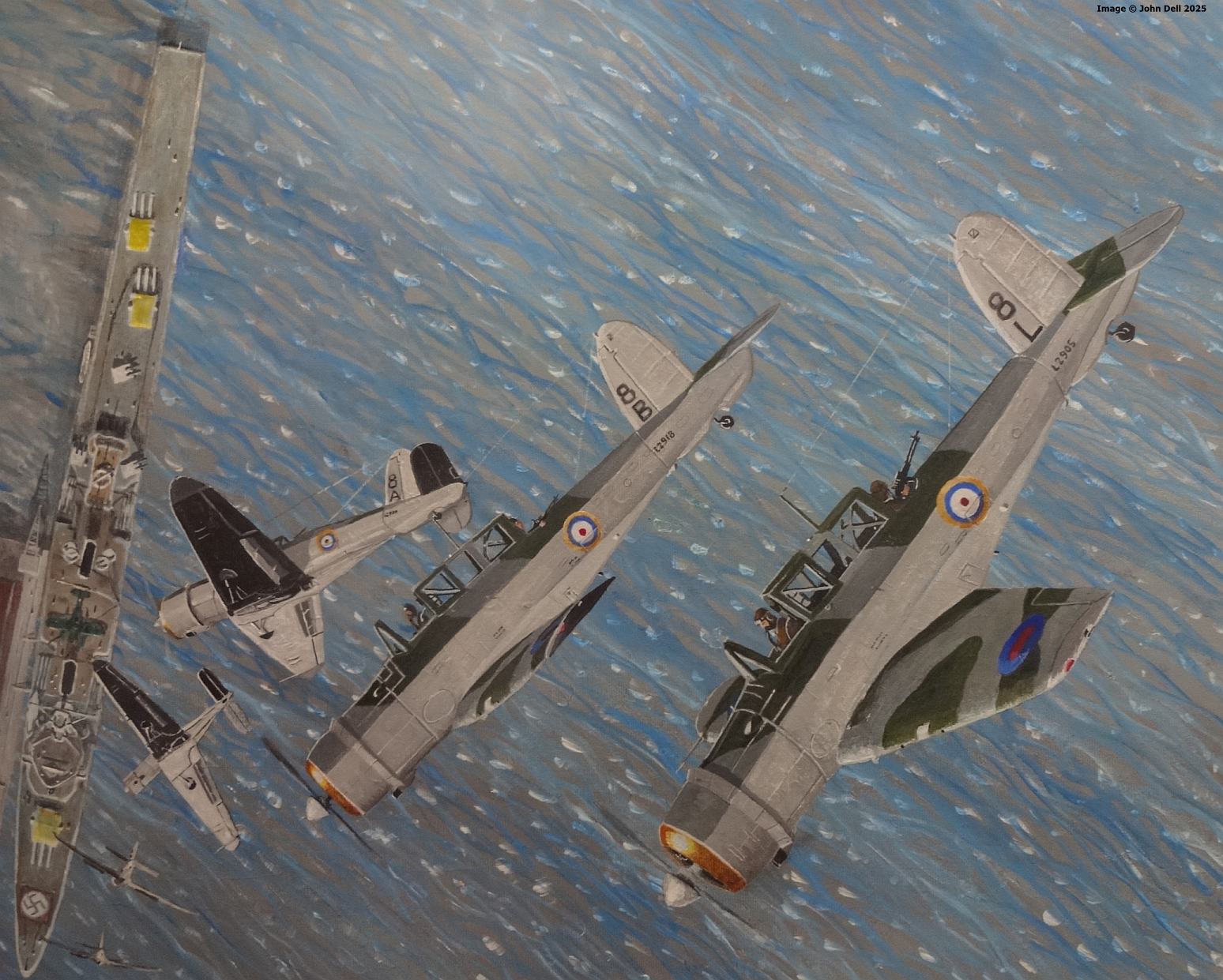
The first wave of Blackburn Skuas flip over to attack the German cruiser Königsberg at Bergen harbour, 10th April 1940. A lot of research went into this picture, and I have received help from experts in Norway, the USA and the UK to get it as accurate as possible. Notice the top of the Königsberg's turrets had been painted yellow and a flag spread on her foredeck to aid recognition by the Luftwaffe. To read more about the sinking <click here>. Image © John Dell
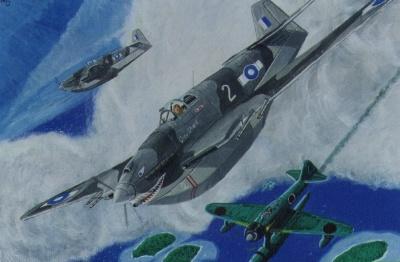
The Blackburn B44 was based on the Firebrand single-seat fighter but with a retractable pontoon float built into the bottom of the fuselage for taking off and alighting on water. Two small additional stabilising floats retracted into the wings. I've painted it as if it had gone into service in the Pacific theatre, attacking a Japanese A6M2-N floatplane fighter. Image © John Dell

DH 93 Dons, painted as if they had gone into service as originally intended.
The Don was originally designed as an aircrew trainer for the RAF - to read about it <click here>. Image © John Dell
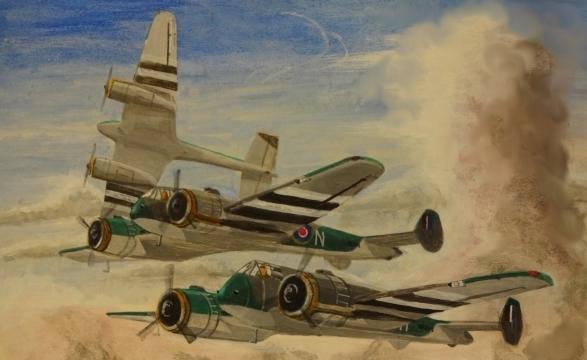
Another project that used the no-allowance shooting principle was the Gloster G39 F9/37 twin engined fighter. Two prototypes were built. Armament was to be a total of five 20mm cannons which all pointed upwards at 12 degrees. I've painted them as if they had gone into service in black and white "D-Day stripes". Image © John Dell
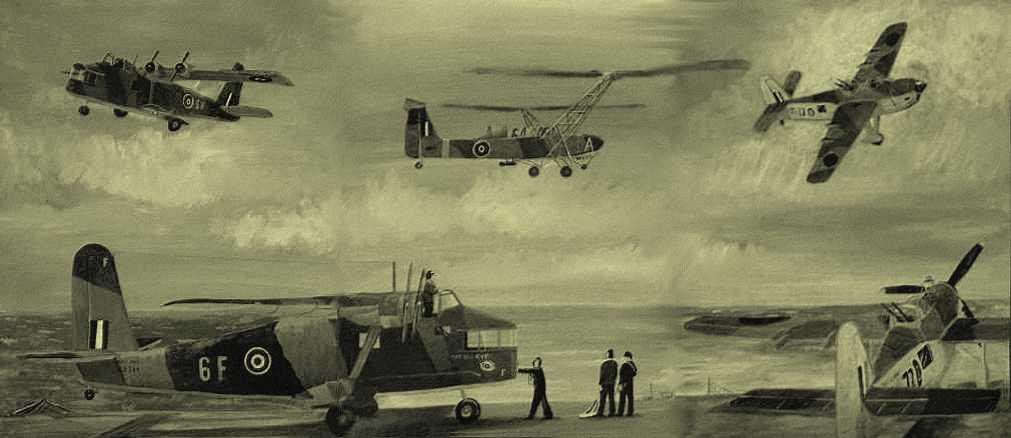
A "tryptych" picture of an alternative Royal Navy carrier scene featuring some projects that never made it into service. On the left is the four engined General aircraft GAL38 fleet shadower. In the middle is a developed version of the Weir W-6 helicopter. On the right is the Folland Fo116 E28/40 project for a torpedo bomber. Painted as three separate colour pictures, this shows them merged into one greyscale image. Image © John Dell
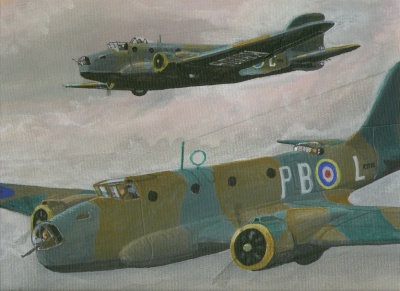
The Boulton Paul P79, a design for a night bomber to Air Ministry Spec B3/34 (which was won by the AW Whitley). The design featured a unique set of rotating arms to hold the bombload to do away with the need for large bomb bay doors. Boulton Paul prepared designs for two versions; one with a second pilot's cockpit to use as a trainer. Image © John Dell
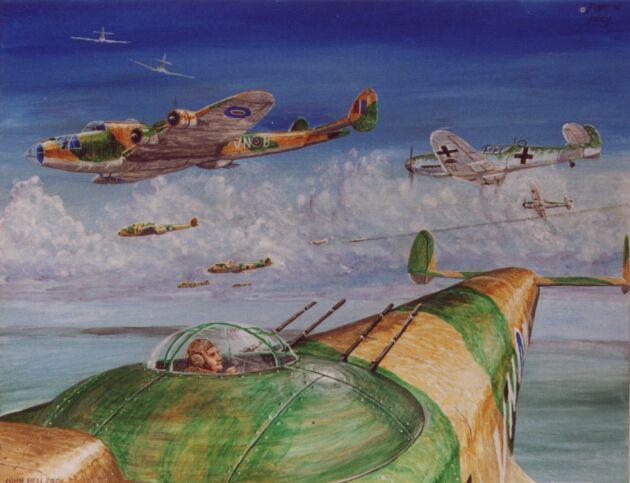
Bristol Type 159 bombers with cannon-armed turrets painted as if they had gone into service. Being attacked by Messerschmitt Bf109F fighters. Image © John Dell
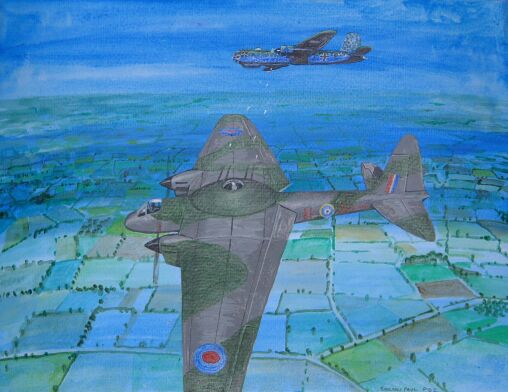
The same type of turret on a Boulton-Paul Type P92 twin engined fighter, giving a Heinkel He 177 a pasting. Image © John Dell
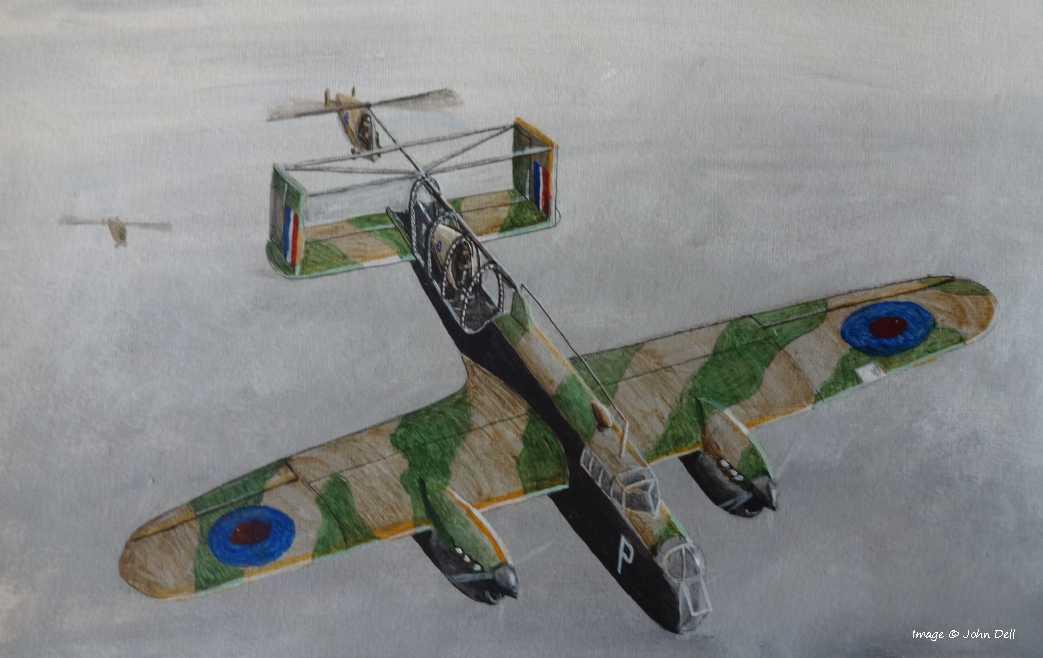
Hafner Rotachutes being deployed from a Whitley. To read about the Hafner Rota projects <CLICK HERE>. Image © John Dell
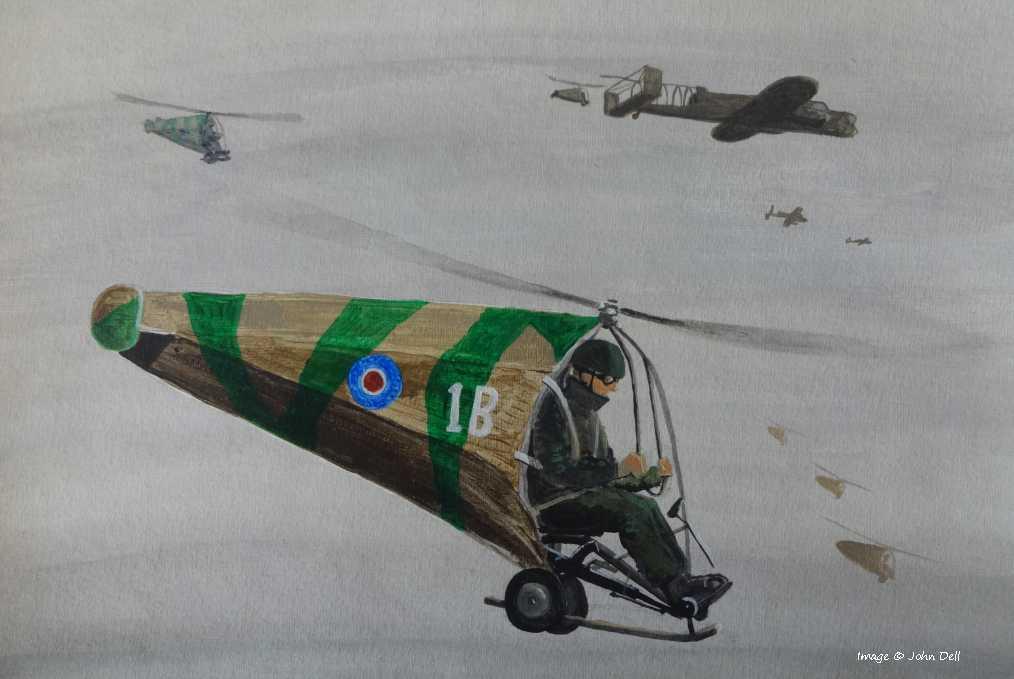
Rotachute in flight. Image © John Dell
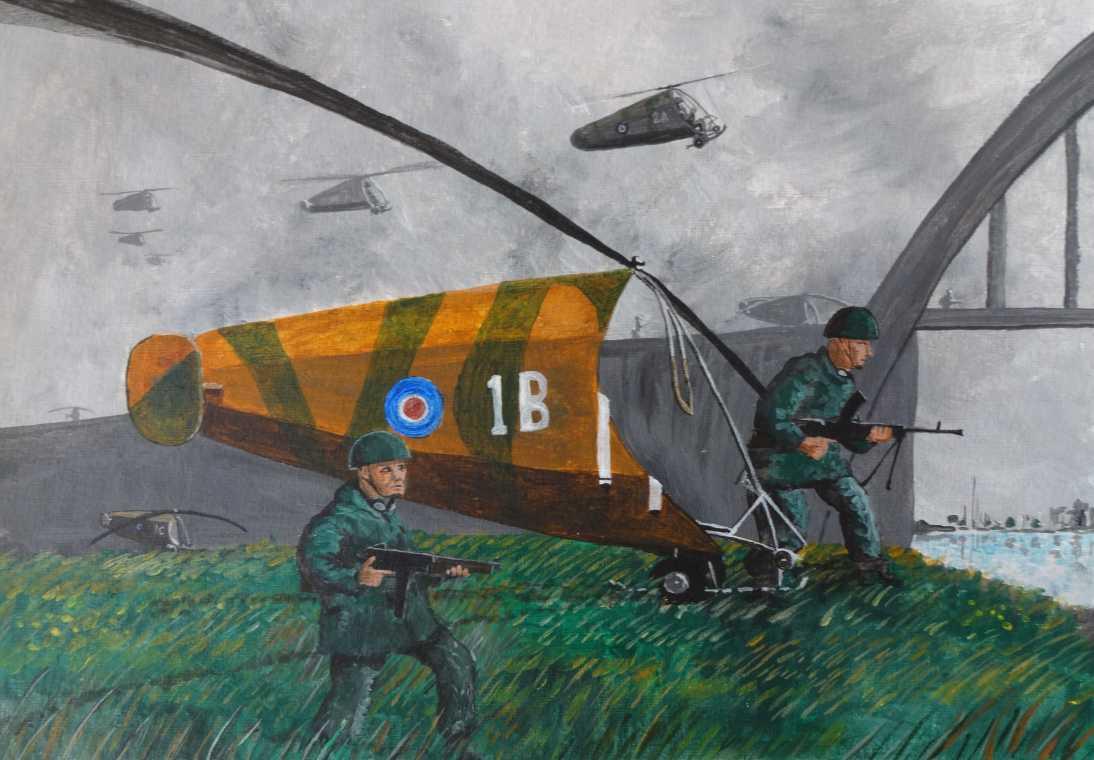
Rotachute landed. Image © John Dell

Hafner Rotabuggy. Image © John Dell
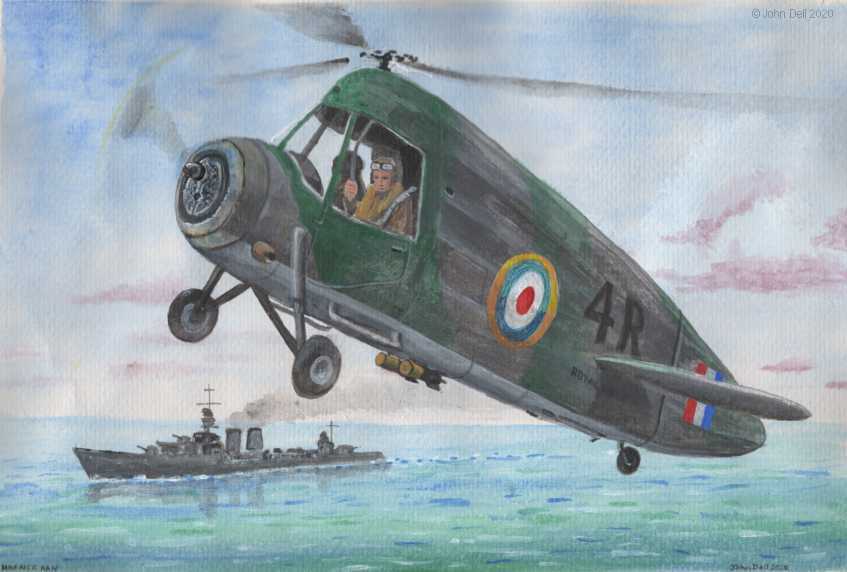
Hafner AR IV, read about the Hafner autogyro and helicopter products at <This Link>. Image © John Dell
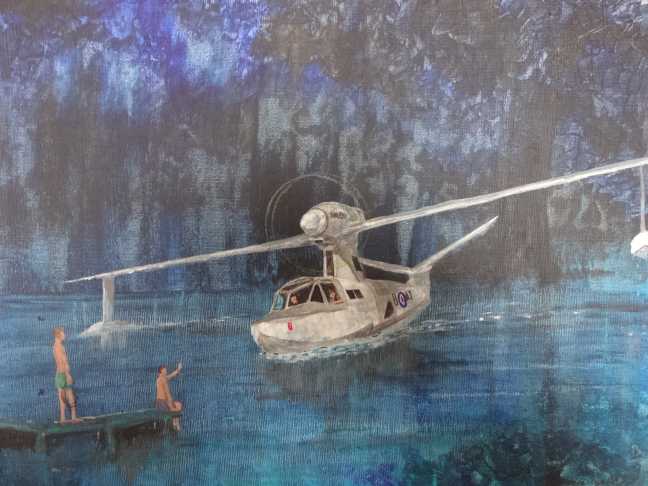
Supermarine Type 347 as originally designed with "V" tail. It was subsequently redesigned and evolved into their Seagull ASR. Image © John Dell

Miles M20 fighter. Image © John Dell
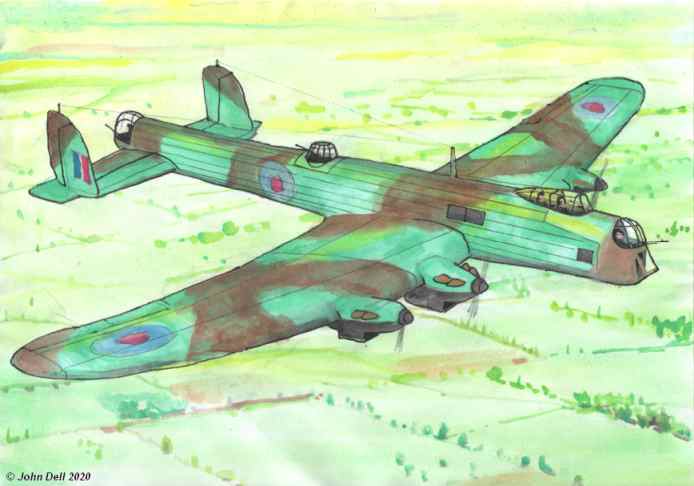
The "Superhendon", a planned four-engined derivative of the Fairey Hendon. Image © John Dell

The Gloster E1/44 "Ace" painted as if it had seen service at the end of WW2, attacking Me262 jets. Image © John Dell

In Issue 36 of "The Aviation Historian" magazine, was an article by Philip Jarrett describing the wacky "flying house" that inventor Andre Delprat built in the garden of his London home in 1906. I did this illustration to show how the crazy, steampunk, contraption was meant to work with the top set of paddles intended to lift it into the air and the bottom paddles meant to propel it along, like the oars on a boat. The drawing was featured in the letters column of issue 38 of the magazine.
